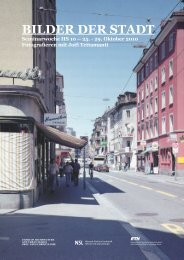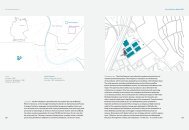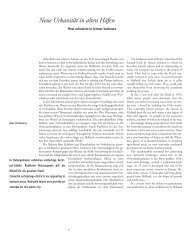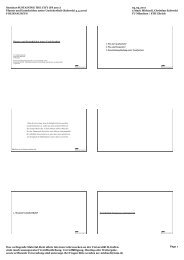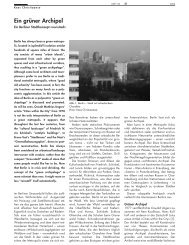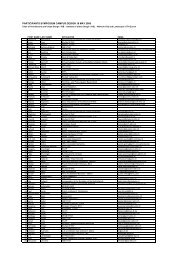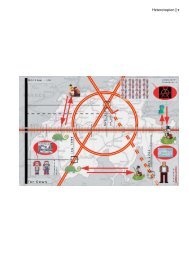dokumentation easa005.ch - professur für architektur und städtebau ...
dokumentation easa005.ch - professur für architektur und städtebau ...
dokumentation easa005.ch - professur für architektur und städtebau ...
Create successful ePaper yourself
Turn your PDF publications into a flip-book with our unique Google optimized e-Paper software.
lecture marathon<br />
Introducing the topic:<br />
The lecture marathon<br />
Monday and Tuesday of the first week were<br />
reserved for an in-depth-introduction to<br />
the topic of easa005:<br />
trans - transit - transition.<br />
In a lecture marathon, a range of invited<br />
lecturers, with different backgro<strong>und</strong>s and<br />
professions, presented their views, information<br />
and research related to the topic.<br />
lecture marathon<br />
trans � transit � transition<br />
Lectures held on Monday, August 8th, 2005<br />
Peter Baccini<br />
Peter Baccini is full Professor of Resource and Waste Manage�<br />
ment at the Department of Civil and Environmental Enginee�<br />
ring at the ETH Zurich. He leads the Swiss Federal Institute<br />
for Water Resources and Water Pollution Control (EAWAG) re�<br />
search group based near Zurich. EAWAG is an interdisciplinary<br />
research team of engineers, environmental scientists, econo�<br />
mists and architects that examines resource management of<br />
heavily populated regions and the long�term behavior of an�<br />
thropogenic sediments.<br />
Josef Estermann<br />
Former mayor of Zurich<br />
As the former mayor of Zurich, Josef Estermann was invited to<br />
EASA to talk about his experience with the city�s �s s urban plan� plan� plan�<br />
ning.<br />
First of all, he described the warm economic growth of the<br />
eighties, followed by the economic recession which divided the<br />
politics in the nineties.<br />
In the eighties, Zurich was the very important center for in�<br />
dustries, but today, not much of the industrial sector is left and<br />
Zurich has become a service city.<br />
To explain this situation, he described the two main models of<br />
urban planning: the «core city» and the «urban sprawl».<br />
The core city is the classical structural model based on the hi�<br />
storical processes of concentration and decentralisation within<br />
urban areas and between urban and rural areas. According to<br />
the classical model, the most favourite locations and the best<br />
traffic conditions are in the core city.<br />
Ruedi Stauffer<br />
Metron architects, Brugg<br />
Metron can look back on a long and successful history. Sin�<br />
ce 1965, the company has made a name for itself with its<br />
progressive traffic plans, housing developments, area deve�<br />
lopment and public buildings. In 1974, ownership of Metron<br />
was taken over by the employees who have run the company<br />
themselves since then. Metron�s �s s main goal is the design of su� su� su�<br />
stainable human spaces and the continuous safeguard of life�s �s<br />
fo<strong>und</strong>ations.<br />
Markus Schaefer<br />
HosoyaSchaefer architects<br />
Zurich/Rotterdam<br />
Hosoya Schaefer is a Zurich and Rotterdam based architectu�<br />
ral design studio. Together with an international list of partner<br />
companies, the office is involved in a broad range of projects,<br />
from research and consulting to building design and realisa�<br />
tion, and is active on various scales, from master planning to<br />
architecture and from brand concepts to media installations.<br />
In his speech on the topic of sustainable energy concept, Pe�<br />
ter Baccini adressed a clear message to the young architects.<br />
Showing a global overview on energy consumption and pro�<br />
duction as well as on the existing resources (renewable or<br />
not), Baccini drew important conclusions for a new generation<br />
of architects and urban planners. They have to play a key role<br />
today in order to reduce our energy consumption, use renew�<br />
able energy and secondary resources that are to be fo<strong>und</strong> in<br />
the new mines (or stocks) constituted by the urban systems<br />
themselves.<br />
The «urban sprawl» is the complementary and counter exam�<br />
ple of the structural model. The «urban sprawl» model takes<br />
as a starting point that cities have lost their former advantages<br />
of being conveniently situated for public and private transport<br />
and therefore preferred for trade and production. Cities are no<br />
more the spider in the web but they are closely connected by<br />
an equal communication network.<br />
In Zurich, 40 years ago, 70% of the population lived in the<br />
core city; today they are less than 40%. The course of histo�<br />
ry shows that the city government failed in the attempt to<br />
keep the manufacturing industry in town. The city planning<br />
was unrealistic and therefore unrealisable. He argued that the<br />
strongest reason for this failure is neither the number of legal<br />
actions nor the government of the canton of Zurich who can�<br />
celled the city zoning, it was, in the first place, the economic<br />
development being unrelenting and irresistable — the so cal�<br />
led globalisation.<br />
Active advancement of social equality and a serious cultural<br />
commitment are major parts of the company`s culture. Met�<br />
ron has led the way in the architecture scene with regard to<br />
interdisciplinary and company organisation.<br />
In his lecture, Ruedi Stauffer mainly talked about the Metron<br />
activities in Tuzla, Bosnia. He explained the Bosnian�Swiss col�<br />
laboration in regard to the Tuzla Center for Ecology and Ener�<br />
gy project.<br />
During his EASA lecture, Schaefer presented the wide range<br />
of research activities of the HosoyaSchaefer agency. He drew<br />
an interesting picture of the global economics and the relati�<br />
onships of big companies with their corporate identity, design,<br />
and finally, architecture. His original position is to try out a<br />
critical intervention (through architecture) within the client�<br />
companies, cracking their strong corporate identity in order to<br />
make innovation possible again.<br />
documentation<br />
71<br />
appendix



